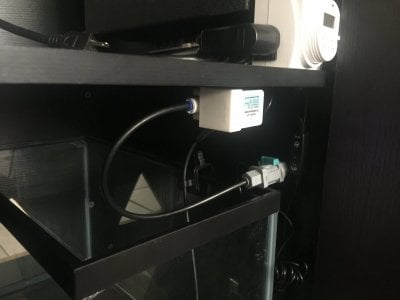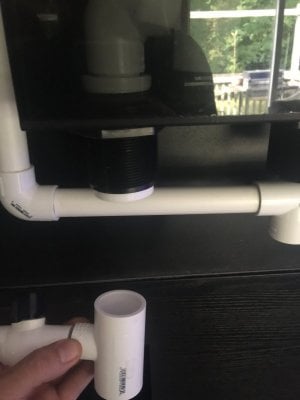- Joined
- Feb 6, 2020
- Messages
- 292
- Reaction score
- 160
First off, I just want to say that I despise doing water changes. I don't mind cleaning the gravel per se, but the whole hauling buckets of water, siphoning, pumping, spilling, and heaven forbid..... Forgetting to turn off the ATO while your doing the water change, so the ATO is dumping fresh water in your tank, diluting the salinity.
Well, I think I've got a simple and inexpensive solution for reducing to near elimination of all this being the 'Waterboy' for your precious pets. I'm all about 'Work smarter, not harder'.
I've been thinking about how to do a AWC without a Apex or controller, cause quite frankly, I just can't justify the cost of one. And since I was lucky enough to find what I consider my 'dream tank' on the used market, and am in the middle of the build right now, I decided to make a separate thread on this topic, rather than it getting lost in my build thread.
Ok, enough of the introduction, on with the theory.
Equipment needed:
Naturally you need a RO/DI unit.

A well pressure tank

A container for mixing fresh salt water. I'm using a 45 Gallon trash can... Don't judge me! I'm not cheap, I'm frugal....

2 RO/DI Floodguardian units. You won't be using one of the electric solenoids in this build, but it's nice to have a spare, for when one fails, and this is inexpensive insurance.

A Auto Aqua Smart AC Socket

A small DC pump like this:

You'll also need a cheap AC pump.... Just a simple pond pump with a 1/2" discharge will be more than adequate, unless you are pushing some crazy high head heights.
Ok, that takes care of supplying a never ending supply of RO water, so you never have to carry buckets of ATO water to your display, as well as a hands free(or bucket free) SW mixing station, I'm sure I've forgotten something....I haven't made a list of all the plumbing fittings, because every situation is different.
This is a long post, so I'll end it here and next post will describe how to hook these things up.
Well, I think I've got a simple and inexpensive solution for reducing to near elimination of all this being the 'Waterboy' for your precious pets. I'm all about 'Work smarter, not harder'.
I've been thinking about how to do a AWC without a Apex or controller, cause quite frankly, I just can't justify the cost of one. And since I was lucky enough to find what I consider my 'dream tank' on the used market, and am in the middle of the build right now, I decided to make a separate thread on this topic, rather than it getting lost in my build thread.
Ok, enough of the introduction, on with the theory.
Equipment needed:
Naturally you need a RO/DI unit.
A well pressure tank
A container for mixing fresh salt water. I'm using a 45 Gallon trash can... Don't judge me! I'm not cheap, I'm frugal....
2 RO/DI Floodguardian units. You won't be using one of the electric solenoids in this build, but it's nice to have a spare, for when one fails, and this is inexpensive insurance.
A Auto Aqua Smart AC Socket
A small DC pump like this:
You'll also need a cheap AC pump.... Just a simple pond pump with a 1/2" discharge will be more than adequate, unless you are pushing some crazy high head heights.
Ok, that takes care of supplying a never ending supply of RO water, so you never have to carry buckets of ATO water to your display, as well as a hands free(or bucket free) SW mixing station, I'm sure I've forgotten something....I haven't made a list of all the plumbing fittings, because every situation is different.
This is a long post, so I'll end it here and next post will describe how to hook these things up.




















